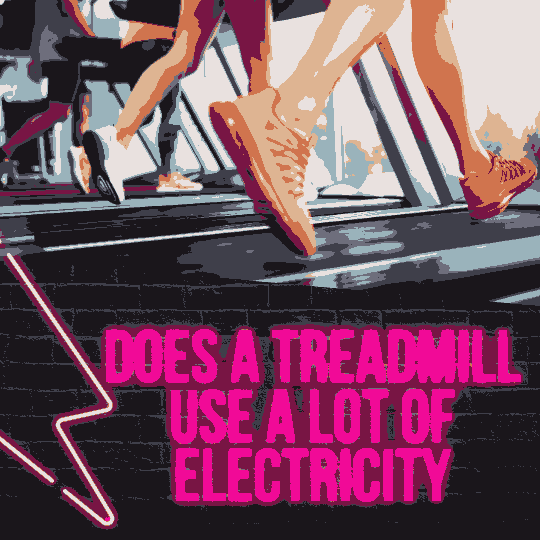3 Secret Tips to Reduce Electricity Usage of Your Treadmill
Move over stationary bikes and ellipticals because treadmills are taking over as the king of home gym equipment!
We all love to save a little cash whenever we can, and one way to do that is by cutting down on electricity costs. And what better place to start than with your trusty treadmill? After all, it’s probably one of the biggest energy-guzzlers in your home gym. But don’t worry, there are plenty of ways to trim down your treadmill’s electricity consumption and save some dough.

Does a treadmill use a lot of electricity?
Oh boy, do treadmills use a lot of power? That’s a tough one. It really depends on the size and power of the motor, the speed and incline settings, and the length of your workout sessions. If you have a tiny little motor that can barely get your legs moving, chances are it will not use that much power.
But if you have a beefy motor that feels like you’re running on a rocket, and you have the speed and incline cranked up to the max, then yeah, it’s probably going to use a decent amount of power. And if you’re a marathon runner and you’re on the treadmill for hours on end?
Well, let’s just say your electricity bill might give you a little bit of a shock (pun intended). So to sum it up: yes, treadmills can use a lot of power, but it all depends on how you use it. Happy running (and saving)!
How much electricity is consumed by a treadmill on average?
Well, that all depends on the wattage of your treadmill and how much you use it. If you have a treadmill with a high wattage and you’re on it for hours on end, it will probably use quite a bit of electricity. But if you have a low-wattage treadmill and you only use it for a few minutes a day, it’s probably not going to use that much electricity at all. So basically, it’s a crapshoot – but at least you’ll have a toned rear end, right?
Have you got the point? No?
Well, it looks like you’re in the market for a new treadmill and want to know about power consumption. Lucky for you, I’ve got all the answers you need (sort of).
Let’s start with the 1.5 hp treadmill. This bad boy will probably use around 100-200 watts of power per hour, depending on how you use it. Not too shabby, right?
Next up is the 2-hp treadmill. This one will probably use more power, in the range of 200-300 watts per hour. Still not too bad, especially if you’re burning off all those calories and saving some cash on your electricity bill.
Then there’s the 2.5-hp treadmill. This one’s probably going to use a bit more power, maybe around 300-400 watts per hour. But hey, at least you’ll be getting a killer workout, right?
Finally, there’s the 3-hp treadmill. This one’s probably going to use the most power out of all of them, maybe around 400-500 watts per hour. But don’t let that discourage you – the extra power will be worth it when you’re crushing your fitness goals and turning heads with your toned physique.
So there you have it – power consumption for four different horsepower treadmills.
Factors that affect how much electricity a treadmill uses
Alright, so you want to know what factors affect how much electricity your treadmill uses? Well, buckle up because we’re about to dive into some exciting stuff.
1. First up: the size and power of the motor
Basically, the bigger and more powerful the motor, the more electricity it will use. So if you have a tiny little motor that can barely get your legs moving, it’s probably not going to use as much electricity as a beefy one that feels like you’re running on a rocket.
2. Next: speed and incline settings
If you’re trying to set a new world record on the treadmill and you have it cranked up to top speed, you can bet that it’s using more electricity than if you were just casually strolling along. The same goes for the incline – the steeper the incline, the harder your motor has to work, and the more electricity it will use.
3. Finally: the length of workout sessions
If you’re a marathon runner and you’re on the treadmill for hours on end, it will use more electricity than someone who gives up after 10 minutes. I mean, seriously, who can run for that long anyway?
So there you have it – the size and power of the motor, speed and incline settings, and length of workout sessions can all affect how much electricity your treadmill uses. Now go forth and save some cash (and the environment)!
Calculating the cost of electricity for a treadmill
So you want to know how to calculate the cost of electricity for your treadmill? Well, you’re in luck because I’m about to lay it all out for you.
How to find the wattage of a treadmill
First things first: finding the wattage of your treadmill. This is where things get a little technical, but don’t worry – I’ll keep it simple. The wattage of your treadmill is essentially a measure of how much electricity it uses. So the higher the wattage, the more electricity it uses (and the more cash it drains from your wallet). You can usually find the wattage of your treadmill in the manual or by contacting the manufacturer.
How to calculate the cost of electricity using the wattage and your local electricity rate
Now that you know the wattage of your treadmill, it’s time to calculate the cost of electricity. To do this, you’ll need to know your local electricity rate (you can find this information on your electricity bill or by contacting your energy provider). Once you have this information, it’s just a matter of plugging it into a simple formula: cost of electricity = wattage x hours of use x local electricity rate.
Voila! You now know how much your treadmill is costing you in electricity each month. Time to start saving some cash (and the environment)!
Tips for reducing the electricity usage of a treadmill
So you want to know how to reduce the electricity usage of your treadmill? Well, don’t worry because I’ve got some tips that are guaranteed to help you save some cash (and the environment).
1. Turn off the treadmill when you’re not using it
I know it sounds like a no-brainer, but you’d be surprised at how many people leave their treadmill on all day (or even all night!) when they’re not using it. Just remember to turn it off when you’re done, and you’ll be well on your way to saving some cash.
2. Use the energy-saving mode (if available)
Most treadmills come with an energy-saving mode that makes the motor run a little slower and use a little less electricity. So if your treadmill has this feature, be sure to turn it on!
3. Use a power strip to easily turn off multiple devices at once
If you have other home gym equipment, such as an elliptical or stationary bike, consider using a power strip to turn them all off at once. This will help you save even more money by reducing electricity usage.
So there you have it – three simple tips for reducing the electricity usage of your treadmill. Start saving some cash (and the environment) today!
FAQs
Q.1 How much electricity does a treadmill use in an hour?
It depends on the motor’s size and power, the speed and incline settings, and how long you’re on the treadmill. But if I had to take a wild guess, I’d say a treadmill probably uses somewhere in the range of a gazillion watts per hour (give or take).
Just kidding, it’s probably closer to around 100-200 watts per hour, depending on how you use it. But hey, at least you’ll be burning off those calories (and saving some cash on your electricity bill).
Q.2 How many amps does a treadmill use?
The amount of amps that a treadmill uses can vary depending on the size and power of the motor, as well as the speed and incline settings. Generally, a treadmill can use anywhere from 8 to 15 amps, with higher-end models tending to use more amps.
To determine the number of amps your treadmill uses, you can refer to the manual or contact the manufacturer. It’s also important to note that the actual amount of amps used will depend on how you use the treadmill and the length of your workout sessions.
Q.3 Should I unplug my treadmill when not in use?
Yes, it is always recommended that you unplug your treadmill when not in use. Not only can this help conserve energy, but it also prevents any potential damage from surges or power outages. Additionally, it may help extend the life of the motor and other components by reducing wear-and-tear while idle. So don’t forget to unplug your treadmill after every workout!
Q.3 Does running on a treadmill use less energy?
Absolutely! Running on a treadmill is a great way to save energy and keep your body fit. Unlike running outdoors, you don’t have to worry about wind resistance or uneven terrain which can be draining. By running on a treadmill you can quickly adjust the intensity of your workout, meaning you can push yourself as far as you want without the extra effort of battling Mother Nature.
Plus, treadmills come with an array of helpful features such as calorie counters and speed settings so you can stay informed on your progress. So yes, running on a treadmill does use less energy than running outside!
Q.4 How Many Watts Does a Treadmill Use?
The average wattage of a treadmill is usually between 500 and 2000 watts, depending on the motor size, speed, and power settings. Some treadmills can use up to 3000 watts or more on higher speed settings. Treadmill wattage can also vary by type (manual or motorized). Motorized treadmills typically use more wattage than manual treadmills.
To get an accurate measurement of a treadmill’s wattage, it is best to consult with the manufacturer or have your gym’s electrician measure it.
Q.4 How Many Amps Does a Treadmill Use?
The typical treadmill usually pulls between 10-15 amps. This number can vary depending on the type of motor and the power settings that you have set. To get an accurate measurement, check the specification sheet of your treadmill.
On average, a 3 horsepower motor will require a minimum of 15 amps although this could be higher depending on your specific model. Additionally, if you are using a heart rate monitor or other accessories with your treadmill, it may draw more current than usual.
Q.5 Do treadmills turn off automatically?
Yes, most treadmills are equipped with an automatic shut-off feature. This feature is designed to turn off the treadmill if it has not been used for a certain period of time, usually 15 minutes or more. The automatic shut-off is designed to help prevent injuries and equipment damage due to long periods of inactivity.
To help you save your electric costs for treadmills, we’ve listed a few non-electric models.
1. Sunny Health & Fitness SF-T1407M Foldable Manual Walking Treadmill
Walking is a great way to improve your mental and physical health, and the Sunny Health & Fitness SF-T1407M Foldable Manual Walking Treadmill is a great way to get started on your fitness journey.
This affordable treadmill requires no electric outlet, is easy to fold and transport with the included wheels, and is low-maintenance. The compact design of the treadmill will allow you to get into shape regardless of the size of your home.
2. SpeedFit Speedboard ProXL
The Speedboard Pro XL is a patented, manual treadmill that provides an incredibly smooth and efficient workout experience. The low-mass, shock-absorbing tread belt system is quiet and operates without friction or wear, making it perfect for those who want an enjoyable and effortless running experience. The Speedboard Pro is also engineered for quality and performance, providing athletes with a durable and long-lasting treadmill that will provide years of trouble-free operation.
3. Assault Fitness AirRunner, Black Frame/Charcoal
Whether you’re looking to improve your fitness or just want to switch up your workout routine, the Assault Fitness AirRunner is a great choice. This treadmill is easy on the environment, as it runs on your energy with zero electrical consumption. Additionally, it’s optimal for all types of training, and its commercial durability means it can last for up to 150,000 miles.
Plus, its natural running feel promotes an efficient running stride, and it can even burn up to 30 more calories than a motorized treadmill. So if you’re looking for a treadmill that’s easy on the environment and your wallet, the Assault Fitness AirRunner is a great option.
4. Asuna High Performance Manual Treadmill
When it comes to working out, we all want to see results. But in order to get results, we need to put in the work. That’s where the Asuna 7700 Hi-Performance Trainer comes in. This self-powered treadmill does it all, from sports-specific training to general fitness and rehabilitation. With its 7700 Hi-Performance Trainer, you can improve both cardiovascular and muscular fitness, helping you reach your ultimate fitness potential.
Bottom Line
In conclusion, there are several simple ways to reduce the electricity usage of your treadmill and save some cash on your energy bill. By turning off the treadmill when it’s not in use, using the energy-saving mode (if available), and using a power strip to turn off multiple devices at once, you can effectively lower the amount of electricity your treadmill uses.
It’s important to remember that small changes can make a big difference, and by following these tips, you’ll be able to save money and help the environment simultaneously. So start reducing the electricity usage of your treadmill today and enjoy the benefits of a more energy-efficient home gym.
You can also check out other trending article on treadmills
1. An Easy-peasy Way to Fix the Slipping Treadmill Belt | Risk Free Options








